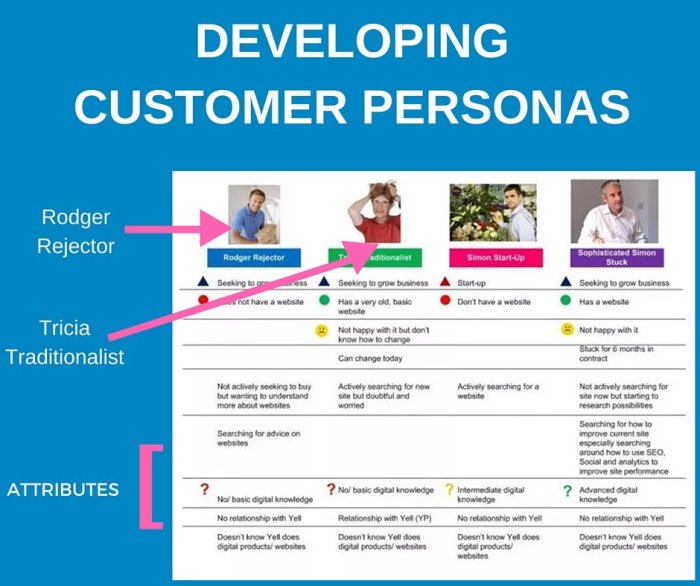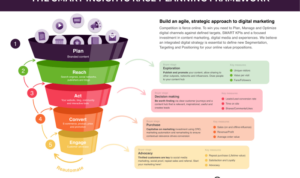Developing Customer Personas dives into the world of creating detailed customer profiles for effective marketing strategies. From understanding the concept to utilizing them in product development, this topic is a must for businesses looking to connect with their target audience on a deeper level.
Understanding Customer Personas
Customer personas are fictional representations of a business’s ideal customers based on market research and real data. These personas help companies understand their target audience better and tailor their marketing strategies to meet the specific needs and preferences of different customer segments.
Examples of Using Customer Personas in Marketing
- Creating targeted advertising campaigns: By developing customer personas, businesses can create ads that resonate with specific customer segments, leading to higher engagement and conversion rates.
- Product development: Customer personas provide valuable insights into what features and benefits are most important to different customer groups, helping companies prioritize product development efforts.
- Personalized messaging: With accurate customer personas, businesses can craft personalized messages that speak directly to the needs and pain points of different customer segments, increasing the effectiveness of their marketing communications.
Importance of Developing Accurate Customer Personas
Developing accurate customer personas is crucial for targeted marketing because it allows businesses to:
- Identify and understand their target audience: Customer personas help businesses identify who their ideal customers are, what motivates them, and how they make purchasing decisions.
- Improve customer engagement: By tailoring marketing messages and strategies to specific customer segments, businesses can increase customer engagement and loyalty.
- Maximize marketing ROI: Targeted marketing campaigns based on accurate customer personas are more likely to resonate with customers, leading to higher conversion rates and a better return on investment.
Creating Customer Personas

Developing customer personas is a crucial step in understanding your target audience and tailoring your marketing strategies to meet their needs effectively. By creating detailed customer personas, businesses can personalize their messaging and offerings to better resonate with their ideal customers.
Steps in Creating Customer Personas
To create customer personas, businesses typically follow these steps:
- Conduct research: Gather data from various sources to understand your target audience’s demographics, psychographics, and behaviors.
- Analyze data: Identify common patterns and characteristics among your customers to group them into distinct personas.
- Create personas: Develop detailed profiles for each persona, including their background, goals, challenges, and preferences.
- Validate personas: Ensure that the personas accurately represent your target audience through feedback and data analysis.
Sources of Information for Developing Customer Personas
When creating customer personas, businesses rely on various sources of information, including:
- Market research: Surveys, interviews, and focus groups can provide valuable insights into customer preferences and behaviors.
- Website analytics: Analyzing website data helps identify visitor demographics, interests, and browsing patterns.
- Social media data: Monitoring social media interactions can reveal customer sentiments, interests, and engagement levels.
- Customer feedback: Reviews, testimonials, and customer service interactions offer direct insights into customer experiences and preferences.
Contribution of Demographic Data, Psychographics, and Behavioral Patterns
Demographic data, psychographics, and behavioral patterns play a significant role in creating detailed customer personas by providing specific insights into:
- Demographics: Age, gender, income, education, and location help categorize customers based on key characteristics.
- Psychographics: Values, attitudes, interests, and lifestyle choices offer a deeper understanding of customers’ motivations and preferences.
- Behavioral patterns: Purchase history, online interactions, and brand engagement indicate how customers interact with products and make buying decisions.
Utilizing Customer Personas: Developing Customer Personas

Businesses apply customer personas in product development by utilizing the detailed information gathered about their target customers. By understanding their customers’ needs, preferences, and behaviors, businesses can tailor their products to better suit the target audience.
Influence on Content Creation and Marketing Messaging
- Customer personas play a crucial role in shaping content creation and marketing messaging by helping businesses create targeted and relevant content. By aligning the messaging with the needs and interests of specific customer segments, businesses can increase engagement and conversion rates.
- Through customer personas, businesses can personalize their communication strategies to resonate with different audience segments. This allows for more effective and impactful messaging that connects with customers on a deeper level.
- Customer personas also help businesses identify the most appropriate channels and mediums to reach their target audience. By understanding where their customers are most active, businesses can optimize their marketing efforts for better reach and engagement.
Improving Customer Engagement and Satisfaction
- Customer personas enable businesses to create customer-centric experiences that prioritize the needs and preferences of their target audience. This leads to higher levels of customer engagement and satisfaction as customers feel understood and valued by the brand.
- By tailoring products, services, and messaging to specific customer segments, businesses can enhance customer loyalty and retention. Customer personas help businesses build lasting relationships with their customers by delivering personalized and relevant experiences.
- Through customer personas, businesses can gather valuable feedback and insights from their target audience, allowing them to continuously improve their offerings and customer experience. This iterative process fosters a culture of customer-centricity and drives long-term success for the business.
Challenges in Developing Customer Personas
Developing customer personas can be a complex process that involves various challenges. From gathering accurate data to keeping up with evolving consumer behavior, businesses face several hurdles when creating effective customer personas.
Identifying Common Challenges, Developing Customer Personas
- Difficulty in obtaining accurate data: One of the biggest challenges is collecting reliable information about customers’ preferences, behaviors, and demographics.
- Lack of resources: Limited budget, time, or staff can hinder the research and analysis needed to create detailed customer personas.
- Overreliance on assumptions: Relying on assumptions rather than data-driven insights can lead to inaccurate customer personas.
Strategies to Overcome Challenges
- Conduct thorough research: Invest time and resources in collecting data from various sources, including surveys, interviews, and analytics.
- Use data analytics tools: Leverage technology to analyze customer data and identify patterns that can help in creating accurate personas.
- Validate assumptions: Test assumptions with real customer feedback and data to ensure the accuracy of the personas.
Impact of Evolving Consumer Behavior
- Changing trends: Consumer behavior is constantly evolving, influenced by factors like technology, culture, and economic conditions.
- Need for continuous updates: Customer personas need to be regularly reviewed and updated to reflect changes in consumer behavior and preferences.
- Adaptation is key: Businesses must be agile and adaptable to adjust their marketing strategies based on evolving customer personas.

